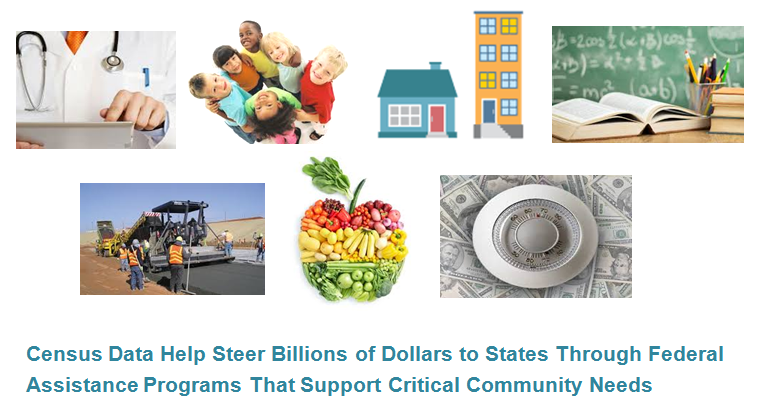
Presented by the Funders Census Initiative. Co-sponsored with Annie E. Casey Foundation, Bauman Foundation, Carnegie Corporation of America, Environmental Granmakers Association (EGA), Ford Foundation, Forum of Regional Associations of Grantmakers, Grantmakers Concerned with Immigrants and Refugees (GCIR), Grantmakers Income Security Taskforce (GIST), Grantmakers in Health (GIH), The Joyce Foundation, Philanthropy New York, Open Society Foundations and Unbound Philanthropy
This webinar presented new tools to support philanthropic and field work to reach a fair and accurate census count including the Counting for Dollars Project – an effort to identify all federal financial assistance programs that rely on decennial census-derived data to guide the geographic distribution of funds – and the Hard-to-Count Mapping Project that helps identify areas with significant numbers of people most likely to go uncounted. You will learn how to access and use this valuable data to inform your strategy, support your grantees, and invest your resources as you prepare for Census 2020. In addition, this webinar included updates on challenges for funding, design and implementation of the census.
Moderated by Karen K. Narasaki, Bauman Foundation [bio]
Speakers
- Andrew Reamer, George Washington Institute of Public Policy, George Washington University [bio]
- Steven Romalewski, Center for Urban Research at The Graduate Center / CUNY [bio]
- Flo Gutierrez, The Annie E. Casey Foundation
KEY TAKEAWAYS
Access the Recording (available to FCCP members only)
Census 2020 Updates
The House and Senate Subcommittees have basically followed the President’s proposed 2018 budget which falls at least $300 mm short of the $1.8 billion that is minimally required.
- Consequences of underfunding in 2017 and possibly 2018: (1) Telephone follow-up on those who don’t return the American Community Survey curtailed. Research on messaging, and opening of regional census offices, delayed;(3) Two of three sites for 2018 ‘dress rehearsal’ canceled, leaving only Providence County, RI, site; and (4) 2017 site tests of methods for counting rural areas and American Indian reservations without city-style addressing, as well as census methods in Puerto Rico and testing of advertising and partnership program in the dress rehearsal, all canceled.
- Launched: Local Update of Census Addresses (LUCA) program. States, counties, cities, and Tribal governments should be registering now to participate in this voluntary program.
We are closely monitoring who will be the President’s nominee for the Census Director.
Counting for Dollars Project
The project aims to identify each federal program that distributes financial assistance geographically based on data derived from the census and ascertain the connection between Census accuracy and the fair, equitable distribution of funds to states and, eventually, local areas. This first phase highlights the 16 largest census-guided federal programs. The project’s second phase will capture over 300 programs.
Counting for Dollars Project Slides
Key Report Findings:
- In FY2015, the 50 states plus the District of Columbia received $589.7 billion from 16 largest Census-guided programs: Medicaid, SNAP, Medicare Part B, Highways, Section 8 HCVs, Title I to LEAs, School Lunch, Special Education, S-CHIP, Section 8 PBVs, Head Start, WIC, Foster Care, Health Centers, LIHEAP, and CCDF.
- Twelve grant-making programs distributed $427.7 billion, 68.5 percent of all federal grants. Of these, nine made $401.4 billion in grants to state governments, 70.1 percent of all federal grants to states.
- Four programs providing direct payments to individuals distributed $162 billion.
- 15 of the 16 programs focus on populations in need. The amount of state funds received was based on 2010 census count. The more accurate the 2010 count, the more fair and equitable that state’s share of federal funds.
- Census undercounts would reduce population estimates, which would lead to less funds for Medicaid, highways and foster care. Undercounts of low-income households and ones with young children would lead to an underestimation of the needs for programs that impact those populations.
Hard-to-Count Mapping Project
Hard to Count Mapping Project Slides
- The 2020 definition of “Hard to Count” is based on census tracts with 2010 mail-return rates of 73% or less.
- CUNY Mapping Services will reprise the 2010 hard-to-count interactive map and make it available in phases for advocacy efforts and “get out the count” campaigns. It will include a zoom feature, location-specific demographic data, links to other resources, and print and download options.
- The Leadership Conference will produce fact sheets based on hard to count tables that provide population counts and percentages, and rankings by count and percent for geographic areas and specific population groups.
Key Takeaways for Funders from Flo Gutierrez, The Annie E. Casey Foundation
The Annie E. Casey Foundation Slides
- The Census is critical to our work and democracy
- Target relevant states and policymakers
- Target the states and communities where Hard-To-Count are concentrated
- Mobilize network of powerful allies (civil rights organizations, business sector, researchers, philanthropy)
- Educate yourselves and your grantees
- Use data to target investments
- Form local funder collaboratives
- Participate in the Funders Census Initiative 2020
Next Steps
- The initial version of the interactive Hard To Count mapping tool will be ready in a few weeks, and there will be a series of webinars that will help funders and advocates use it effectively.
- We need state and local governments to put funds in to support the count, and this will require advocacy.
- Early funding to organizations for education and get-out-the-count is crucial. Organizations need to start planning 2020 Census activities in 2018, in order to go into the field with effective educational messaging in 2019.
Resources
- Counting for Dollars Report and Tables
- Hard-to-Count Mapping Project
- The Leadership Conference on Civil and Human Rights 2020 Census webpage
- For the latest news on census policy developments, please visit The Census Project
Updates and resources on the census for funders can be found on FCCP’s Funders Census Initiative page